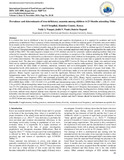| dc.description.abstract | It is evident that iron in childhood is key for proper health and cognitive development as it is required for academic and wo rk productivity in adulthood. There is paucity of data concerning the prevalence of IDA in children aged 6-23 months since most studies focus mainly on the selection of iron rich foods as criteria for determining those at risk of IDA. The age limit in most of these studies is 5 years and above. There is limited scientific data on the prevalence and determinants of IDA in children aged 6-23 months old in Thika Level 5 Hospital attending well baby clinic (WBC). A cross-sectional analytical study design was adopted for the study in the month of May 2013. The study targeted a sample size of 241 children selected by systematic random sampling method. Data were collected by researcher administered interview schedule given to mothers or caregivers of the children attending the WBC at Thika Level 5 Hospital. This was followed by a collection of venous blood samples from children for hemoglobin, red cell width and mean cell volume determination. The study participants were also followed up to their homes at a later date to quantify the utensi ls used to measure food. The data were cleaned coded and analyzed using SPPS Version 20. Data on dietary intake was analyzed using Nutri-survey statistical package (2008) and ENA for smart (2008) was used to analyze anthropometry. Descriptive statistics were used to describe the daily intake of nutrients, sanitation, economic and socio-demographic factors. IDA status was based on hemoglobin levels while predictors of complementary feeding practice were considered an indicator of proper food intake. Chi -square test was used to determine the relationship between IDA with dietary intake of iron-rich foods and complementary feeding practices. Binary logistic regression was used to test the significance between IDA with malaria, helminthic infestation and immunization status. The level of significance of accepting the null hypotheses was <0.05. The minimum dietary di versity was (34%), minimum meal frequency (58%) and minimum acceptable diet was (58%). Binary logistic regression analysis revealed significant relationships between malaria with IDA (ODDS Ratio [OR] =2.95, CI=0.72 -3.22, p=0.013), helminthic infestation with IDA (ODDS Ratio [OR] = 3.87, CI=0.84-4.12, p=0.001) and immunization status with IDA (ODDS Ratio [OR] = 2.98, CI = 0.63 -3.16, p=0.032). Mean hemoglobin values from the present study were found to be (8.3 2.3g/dl) whereas the overall IDA prevalence was (73.2%) indicating severe IDA among children attending a WBC at Thika Level 5 Hospital. Determinants of IDA included; the age of the child, education of the caregiver, the occupation of the caregiver, complementary feeding practices, dietary intake of iro n-rich foods, rubbish waste disposal, human waste disposal, the presence of stagnant water, malaria infection, deworming practices, helminthic infection and immunization. Aggressive awareness campaigns targeting proper complementary feeding and proper iron –rich diet for mothers with under five-year children in hospitals, markets and chief’s barazas should be launched by all stakeholders in (IYCF) Infant and young child feeding. | en_US |

